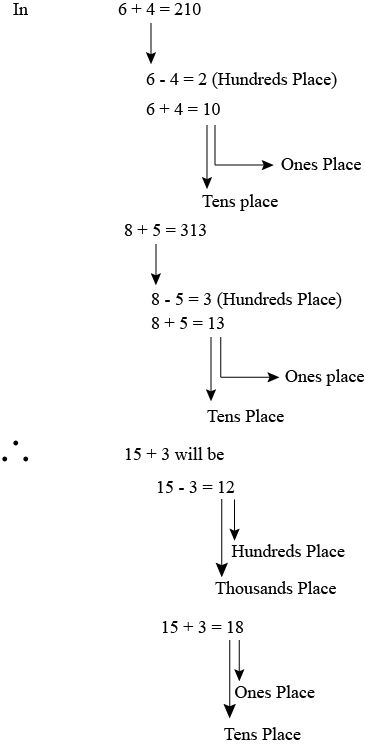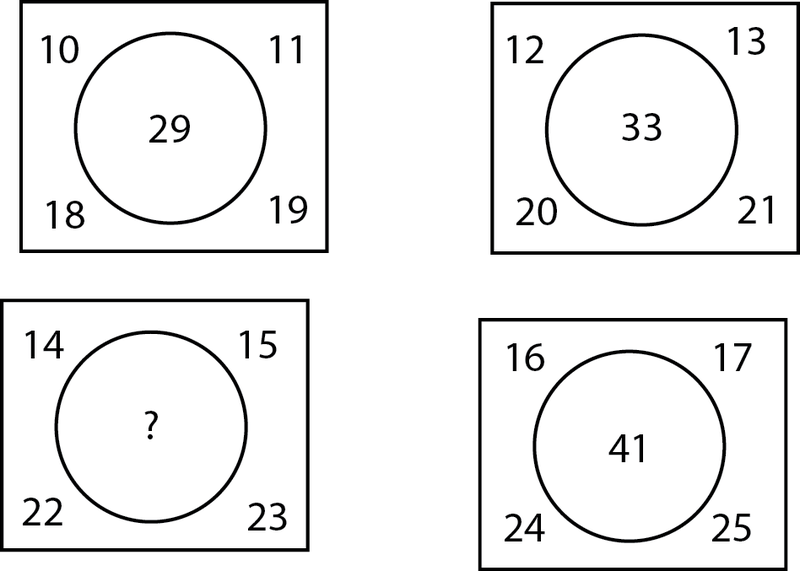5th Grade > Mathematics
PATTERNS MCQs
Total Questions : 37
| Page 1 of 4 pages
Answer: Option B. -> 1218
:
C
In the above pattern, we observe thateach row in a figure has one more block than the one in the previous figure in that row.
For example, in the second figure:
The first row has three blocks, which is one more than the number of blocks in that row in the first figure.
The second row has two blocks, which is one more than the number of blocks in that row in the first figure.
The third row has three blocks, which is one more than the number of blocks in that row in the first figure.
Also, the new blocks in all the rows areadded to the left.
So, the fourth figure will have, 5 blocks in the first row, 4 blocks in the second row and 5 blocks in the third row.
So the figure that will come next in the pattern is :

:
C
In the above pattern, we observe thateach row in a figure has one more block than the one in the previous figure in that row.
For example, in the second figure:
The first row has three blocks, which is one more than the number of blocks in that row in the first figure.
The second row has two blocks, which is one more than the number of blocks in that row in the first figure.
The third row has three blocks, which is one more than the number of blocks in that row in the first figure.
Also, the new blocks in all the rows areadded to the left.
So, the fourth figure will have, 5 blocks in the first row, 4 blocks in the second row and 5 blocks in the third row.
So the figure that will come next in the pattern is :

Answer: Option A. -> 12345
:
A
In the pattern above, one more digit is added to the previous term. Also, the new digit is one more than the value of the digit at the units place in the previous term.
So, the next term after 1234 will be12345.
:
A
In the pattern above, one more digit is added to the previous term. Also, the new digit is one more than the value of the digit at the units place in the previous term.
So, the next term after 1234 will be12345.
Answer: Option B. -> VMTORHS
:
B
According to the given code of secret language,
E→VN→MG→TL→OI→RS→HH→S∴Originalmessage−ENGLISHSecretmessage−VMTORHS
:
B
According to the given code of secret language,
E→VN→MG→TL→OI→RS→HH→S∴Originalmessage−ENGLISHSecretmessage−VMTORHS
Answer: Option B. -> 49, 64
:
B
The terms in the sequence are:
1=1×14=2×29=3×316=4×425=5×536=6×6
We observethat the nth term in the sequence is n × n.
So, the 7th term of the sequence = 7 × 7 = 49
The 8th term in the sequence = 8 × 8 = 64
So, the next two terms in the sequence are 49, 64.
:
B
The terms in the sequence are:
1=1×14=2×29=3×316=4×425=5×536=6×6
We observethat the nth term in the sequence is n × n.
So, the 7th term of the sequence = 7 × 7 = 49
The 8th term in the sequence = 8 × 8 = 64
So, the next two terms in the sequence are 49, 64.
Answer: Option B. -> 37
:
B
In the above figures, we observe that the sum of the numbers diagonally opposite to each otheris equal to the number in the circle.
For example, in the first square 10 + 19 = 18 + 11 = 29
So, the number in place of '?' = 14 + 23 = 15 + 22 = 37
:
B
In the above figures, we observe that the sum of the numbers diagonally opposite to each otheris equal to the number in the circle.
For example, in the first square 10 + 19 = 18 + 11 = 29
So, the number in place of '?' = 14 + 23 = 15 + 22 = 37
Answer: Option B. -> 22 B
:
B
The above sequence can be split into two sequences, one having numbers and another having alphabets:
The number pattern is as follows:

So, the next term in the above pattern is 22.
The sequence of the alphabets is:
F, E, D, C
We observe that the alphabets are in reverse alphabetical order.
Sothe next term in the sequence of alphabets is B.
So, the next term in the sequence is 22 B.
So, the sequence becomes12 F, 13 E, 15 D, 18 C, 22 B.
:
B
The above sequence can be split into two sequences, one having numbers and another having alphabets:
The number pattern is as follows:

So, the next term in the above pattern is 22.
The sequence of the alphabets is:
F, E, D, C
We observe that the alphabets are in reverse alphabetical order.
Sothe next term in the sequence of alphabets is B.
So, the next term in the sequence is 22 B.
So, the sequence becomes12 F, 13 E, 15 D, 18 C, 22 B.
Answer: Option A. -> 82
:
A
The sequence follows 2, 5, 10, 17, 26, 37, 50, 65, ___.
We can observe,
5 - 2 = 3
10 - 5 = 5
17 - 10 = 7
26 - 17 = 9
37 - 26 = 11
50 - 37 = 13
65 - 50 = 15
If we find the difference between the differences between any two consecutive terms, it is equal to 2.
So, the next term in the sequence will be (15 + 2) or 17 more than the last given term.
That is,
65 + 17 = 82
:
A
The sequence follows 2, 5, 10, 17, 26, 37, 50, 65, ___.
We can observe,
5 - 2 = 3
10 - 5 = 5
17 - 10 = 7
26 - 17 = 9
37 - 26 = 11
50 - 37 = 13
65 - 50 = 15
If we find the difference between the differences between any two consecutive terms, it is equal to 2.
So, the next term in the sequence will be (15 + 2) or 17 more than the last given term.
That is,
65 + 17 = 82
Answer: Option B. -> E25V
:
B
The terms of the above sequence can be split into three sequences.
The first alphabet of each term: A, B, C, D
These are in alphabetical order, so the next term will have the alphabet E.
The sequence of numbers: 5, 10, 15, 20
These numbers are the multiples of 5, so the number in the number in the next term is 25.
The second alphabet of each term: Z, Y, X, W
These terms are in reverse alphabetical order, so the second alphabet in the next term is V.
Therefore, the next term in the sequence is E25V.
:
B
The terms of the above sequence can be split into three sequences.
The first alphabet of each term: A, B, C, D
These are in alphabetical order, so the next term will have the alphabet E.
The sequence of numbers: 5, 10, 15, 20
These numbers are the multiples of 5, so the number in the number in the next term is 25.
The second alphabet of each term: Z, Y, X, W
These terms are in reverse alphabetical order, so the second alphabet in the next term is V.
Therefore, the next term in the sequence is E25V.
Answer: Option D. -> 64
:
D
The sequence follows:
144, 121, 100, 81, ____
144=12×12121=11×11100=10×1081=9×9
We can see that each term of the sequence is the square of a number. It means a number is multiplied by itself.
Also, the number multiplied with itself in the following term is one less than the previous term.
So, the next term in the sequence is the square of 8, which is
8×8=64
:
D
The sequence follows:
144, 121, 100, 81, ____
144=12×12121=11×11100=10×1081=9×9
We can see that each term of the sequence is the square of a number. It means a number is multiplied by itself.
Also, the number multiplied with itself in the following term is one less than the previous term.
So, the next term in the sequence is the square of 8, which is
8×8=64


















